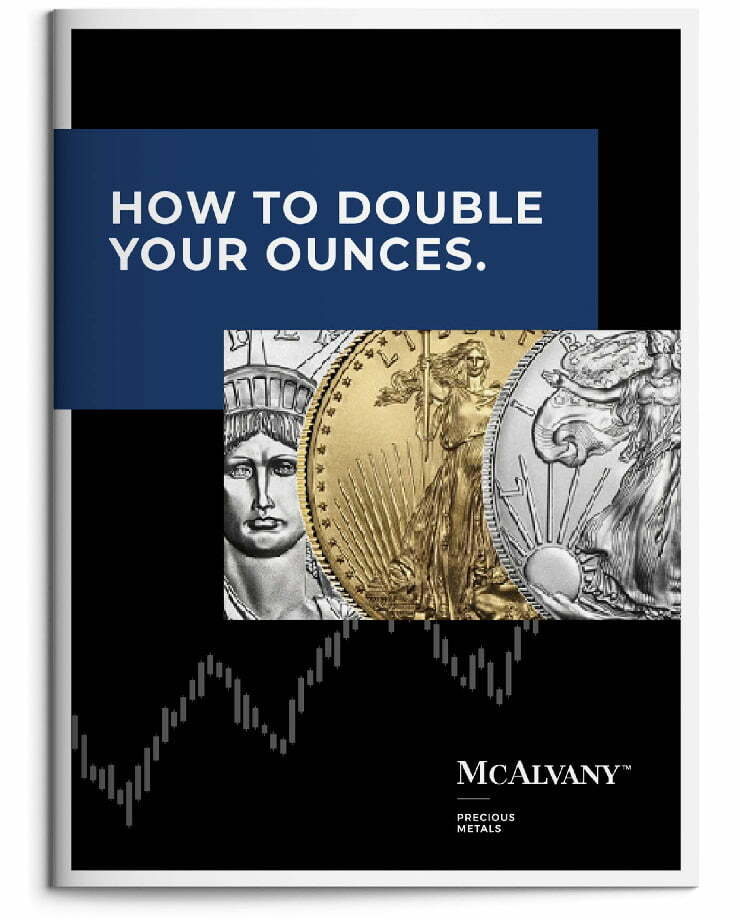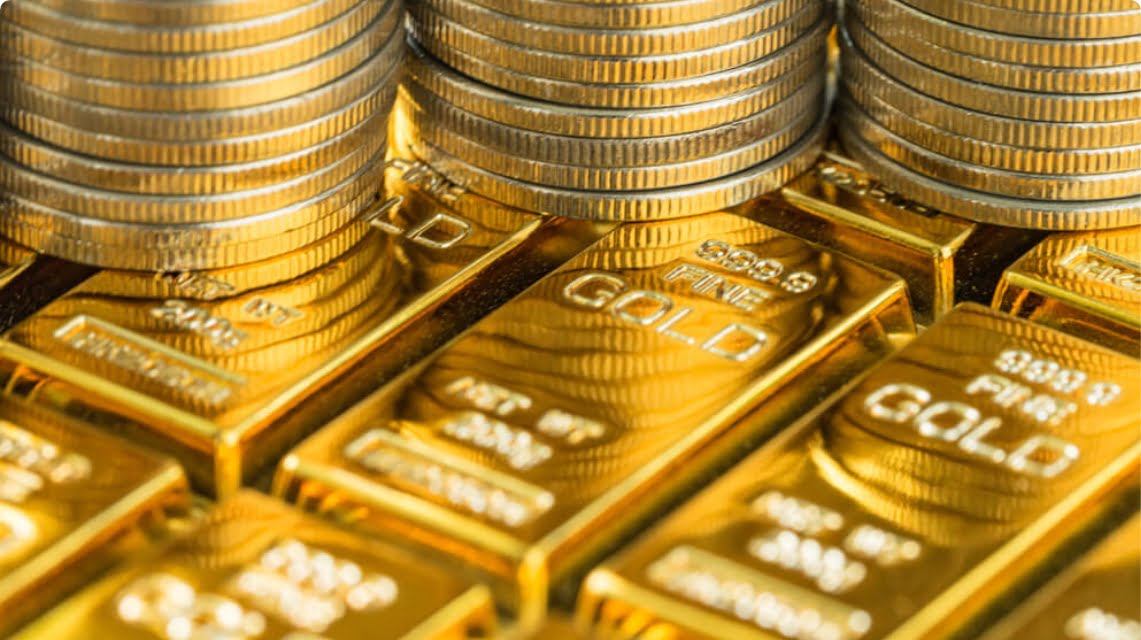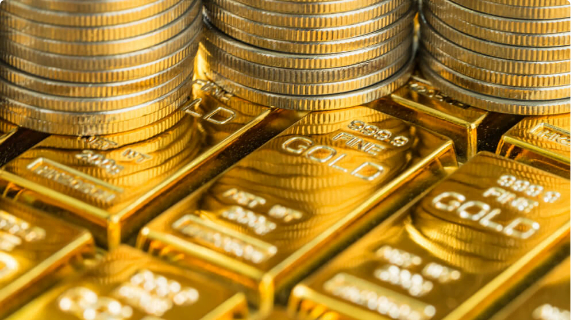Last week, McAlvany Wealth Management held its annual client conference. It was a pleasure, as always, for this author to offer his best take on the dead center bulls-eye fundamentals most crucial to driving the gold market to record high prices.
This week, HAI will present the condensed and consolidated version of that message and update a few recent relevant developments.
In HAI‘s view, while the seeds were sown decades prior, our currently unfolding gold-focused global monetary system regime change (post-petrodollar system) began, in earnest, with the U.S. policy response to the 2008 Great Financial Crisis. In short, the U.S. printed its way out of a crisis it would have demanded all other nations restructure debt to get out of. That is a problem if the currency being debased is the reserve currency, the reserve asset, and the money unit at the center of the post-1971 dollar-based global petrodollar system. Not surprisingly, by many accounts, China and other nations interpreted the 2009 U.S. dollar print-a-thon as an act of betrayal and a de facto financial attack.
In September of 2014, after China had said publicly that it was no longer interested in accumulating dollar reserves on net, China launched the Shanghai Gold Exchange International Board (SGEI) as a unit of the People’s Bank of China (PBOC). This was China’s first truly significant move to establish an alternative to the U.S. dollar reserve system with a gold-based yuan. When paired with deals China signed that same year to buy Russian oil and gas in yuan, the launch of the gold exchange amounted to China opening a Nixonian gold window, except at a floating price of gold. China was taking strides to internationalize the yuan by making the currency easily exchangeable for gold that floats in price. In essence, it was trying to internationalize the yuan by making it trustworthy via easy gold convertibility.
It was a fledgling threat to the predominant post-1971 petrodollar system; it was the start of a global system shock; and it was a monetary system-change tremor. In HAI‘s view, we may now be seeing just the start of the ensuing monetary earthquake.
This effort to insert a gold-exchangeable yuan into the global energy and commodity trade was a clear effort to internationalize the yuan and facilitate international non-dollar trade with net settlement in gold that can then be held as the world’s most trusted reserve asset.
As the WSJ explained in September of 2014, “Traders expect the international board will broaden the global use of the yuan and help to simplify how gold is brought into the country.”
Then in June of 2015, at an LBMA event in Singapore, a PBOC representative explicitly noted that the Shanghai Gold Exchange International and gold were both vital to China being able to invoice oil and gas in yuan.
In the presentation, called “World Needs New Reserve Currency,” the PBOC’s Dr. Yao Yudong explained that, “The gold market and SGEI are vital to the internationalization of yuan… The key function of an international currency is trade invoicing for commodities like oil and gas… We would like to increase usage of yuan in trade invoicing by using gold.”
And that is the key point to understanding the unprecedented nature of our present gold market fundamentals. China publicly made it crystal clear in 2015 that in its newly developing system it wanted to trade energy and commodities internationally in yuan, using gold. In other words, they wanted to internationalize the yuan by using the Shanghai Gold Exchange International Board to make yuan easily convertible to gold internationally.
So in this system, China and its trade partners avoid concerns over dollar shortages (threatening their ability to buy needed energy and other commodities only available in dollars under the petrodollar system) and avoid U.S. dollar weaponization threats by increasingly transacting for energy and commodities in yuan and net settling in gold rather than U.S. Treasuries as the reserve asset.
Meanwhile, the counterparty in trade with China can easily recycle their yuan back into Chinese products. After all, China has become the “factory of the world” and undisputed manufacturing superpower over the last 30 years. Then, any surplus yuan can easily be exchanged into gold at the Shanghai Gold Exchange International Board.
Now that is an intriguing system. It’s arguably superior to the petrodollar system because, unlike U.S. Treasuries, gold is the neutral reserve asset with no counterparty risk that always preserves its value and that everybody trusts.
In 2019, highly respected former US Trade Rep and senior advisor to four Presidents Harald Malmgren confirmed China’s intentions in a post on Twitter/X. In an aside to comments on the China/U.S. trade spat during Trump’s first term, Malmgren wrote, “Quietly, China continues aim for gold-based yuan.”
Most recently, and perhaps most significantly, in June of this year Bloomberg reported that “China Opens First Offshore Gold Vault in Hong Kong.” This is a very significant development in China’s efforts to internationalize the Shanghai Gold Exchange and, along with it, the yuan. This strategic move by China to launch an offshore physical gold delivery vault in Hong Kong is the first in its plan to establish an interconnected network of delivery vaults in key financial centers such as Singapore, Zurich, and Dubai that will establish a 24-hour trading ecosystem designed to challenge traditional Western dominance in gold pricing and physical delivery.
According to the Bloomberg report, “The new contracts will be denominated in yuan and settled by cash or physical delivery, with the goal of promoting wider use of the yuan in international trade and reducing reliance on the US dollar… The launch serves a number of purposes, from broadening the Shanghai bourse’s international reach to strengthening China’s clout in commodity and currency markets.” And again, according to Bloomberg, “the denomination of the SGE’s new contracts in yuan is particularly important given Beijing’s ambition to reduce reliance on the US dollar and promote wider use of the yuan in international trade.”
This new launch of multiple yuan-denominated international gold trading vaults that establish 24-hour trading is, in HAI‘s view, the final major step to truly validating and establishing an internationalized gold-based yuan and turbocharging the accelerated international adoption of a new gold-based global trading system.
These are the breadcrumbs that lead to a conclusion you don’t hear about in the mainstream Wall Street narrative or in coverage by the mainstream Western media: the global system is very likely changing. We’re not in Kansas anymore, and soon we may not be in the petrodollar system either.
If that sounds too far-fetched to believe, consider recent comments by Jeff Currie, former Goldman Sachs Head of Commodity Research. In June of 2025, he told MacroVoices, “The petrodollar system that has been there for 75 years, it’s now gone… I think gold is going to be the biggest benefactor.”
Now, if you have doubt that the U.S. would never let that happen, you’re in good company. However, HAI is not so sure the U.S. will want to stop a global system change from the dollar reserve system, even if it could.
That’s because, as economist Robert Triffin famously exposed in 1960, there is a fundamental flaw in the modern international monetary system. In what’s since become known as “Triffin’s dilemma,” Triffin explained that the hegemonic benefits of being the reserve currency nation outweigh the costs at first. But the dilemma is that while the benefits of being the reserve currency issuer stay relatively static, the costs compound over time. Eventually, the costs outweigh the benefits and the system becomes unsustainable and hits a breaking point.
In HAI‘s view, now decades into this petrodollar system, the crippling consequences of Triffin’s dilemma have clearly arrived for the U.S.—and this administration appears to know it.
In a nod to the very problems Triffin described decades earlier, Secretary of State Marco Rubio said in January, “If we stay on the road we’re on right now, in less than 10 years virtually everything that matters to us in life will depend on whether China allows us to have it or not.”
And it’s not just Rubio. In HAI‘s view, no one has articulated the ruinous impact that the post-1971 dollar-based global system is now having on the United States better than U.S. Trade representative Jamieson Greer.
In an August New York Times op-ed, U.S. Trade rep Greer was definitive in condemning the current global system as “untenable and unsustainable.”
As Greer put it, “Our current, nameless global order…is untenable and unsustainable… The United States has paid for the system with the loss of industrial jobs and economic security, other countries have been unable to make needed reforms, and the biggest winner has been China with its state-owned enterprises and five-year plans.”
Referring to the post-1971 dollar recycling system, Greer said:
“Our trading partners were adept at this game, and elites on Wall Street and in Washington were all too happy to cash in on the global arbitrage by moving production abroad.
“The net result? The bulk of global manufacturing shifted to jurisdictions such as China…while the United States ran up what in absolute terms is the highest trade deficit in the history of the world. This led to extensive and well-documented losses in U.S. industrial capacity and employment as well as reliance on our adversaries for critical supply chains. We subordinated our country’s economic and national security imperatives to a lowest common denominator of global consensus.”
Greer continued:
“Reversing decades of harmful policy that weakened our manufacturing capacity and work force will take time and coordinated effort across the public and private sectors. But keeping the status quo would only accelerate the dangerous trajectory of deindustrialization. We require a generational project to re-industrialize America, and time is short.”
In HAI‘s view, the “generational project to re-industrialize America” referred to by Greer demands that the U.S. cede the petrodollar system as we’ve known it to an alternative, that the U.S. implement highly inflationary industrial policy (official sector money printing to buy the commodities, properties, companies, and assets deemed critical to re-shoring and revitalizing the U.S. manufacturing base), and that the U.S. inflates away (as policy) the net present value of its crippling mountain of debt obligations outstanding.
In HAI‘s view, these realities, still dramatically underappreciated in the West, form the rock-solid foundation for an expectation that gold will move much higher for much longer than even “gold bulls” presently expect.
Monetary regime changes don’t happen every day. They’re generational. By extension, the sort of move higher HAI expects to see in the gold price over coming years as gold is remonetized in the global system as the neutral reserve asset doesn’t happen every day either. It’s also very likely to be a generational move to reprice gold far higher.
Interestingly, over the last two weeks, there has been an additional ripple that could further accelerate gold’s ascent. On October 13th, Reuters reported that Exxon’s CEO said that annual production decline rates in U.S. shale could soon be as high as 15% each year.
According to HAI favorite commodity research firm Goehring & Rozencwajg, U.S. shale has been responsible for ~90% of global oil supply growth over the past decade. If that wellspring starts declining by 15% per year, we’re very likely to see an awfully significant tightening of global oil supply—soon.
This is critically important because (beyond the obvious impact of likely higher oil prices), a decline in U.S. shale production means the U.S. will have to increase U.S. dollar exports in order to import more oil. That’s a catalyst for a weaker dollar, as increased dollar exports will increase international dollar supplies, and the greater international supply will lower international demand for dollars.
But importantly, in light of system change, this lower international demand for dollars (weaker dollar) will also happen as global dollar recycling (dollar oil profits recycled into U.S. Treasuries) is increasingly transitioning toward global gold recycling (oil profits recycled into gold instead of U.S. Treasuries). Given the changing global system, it seems reasonable to expect that the increasing net U.S. dollar outflows to buy oil would weaken the dollar and also be increasingly redeployed into buying gold. And that could certainly be a potent double-barrel accelerant to the already red-hot bull market in the yellow metal.
None of this is to suggest that a near-term correction in gold can’t happen. Despite incredibly bullish fundamental support, at this point a correction should happen just given the absolutely torrid pace of the recent rally in all precious metals. In fact, the rather violent reversal lower in precious metals prices on Friday of this week could certainly have been the start of just such a correction.
The point, however, is that one can draw a direct link from U.S. shale rolling over to increased global dollar exports, a weaker dollar, and an acceleration of global gold recycling that, after a possible shorter-term correction in gold, should all further turbocharge what are already massively stacked, frankly unprecedented fundamentals supporting this gold bull and its continuation.
This week, on Twitter/X, Ray Dalio, legendary founder of hedge fund Bridgewater, said, “I think most people make the mistake of thinking of gold as a metal rather than as the most established form of money, and they think of fiat money as money rather than debt.”
Ultimately, one of the reasons that the ongoing pro-gold monetary regime change described in this HAI is so incredibly significant is because, in time, it’s highly likely to address Dalio’s observation. When this system change is eventually better understood in the West, HAI suspects most people will see gold as the most established form of money. They will also concede that a fiat money unit is debt. When that paradigm shift in Western perspective is finally and fully market-to-market, HAI suspects the gold price will be both miles above its present price and probably a five digit number.
After delving deep into the fundamentals supporting gold, it’s also worth noting a respected technical take on precious metals. Michael Oliver is famously Eric Sprott’s favorite technical analyst (Eric Sprott is among the most successful natural resource investors of the last 50 years). Last Weekend, regarding the set-up in gold, silver, and precious metals miners, Oliver wrote, “While many analysts, traders, and investors are now suddenly impressed by gold and silver action, they also continue to think in ‘norms’ about such trends. ‘Overdone!’ ‘Needs a correction!’ ‘When do I take profits?’ ‘Could be topping!’ The doubting chorus continues to wail.”
Mr. Oliver then continued, “our assessment now is that what’s about to unfold, and rapidly, is an emergence on the upside to a new price reality far above current levels.”
This author isn’t the gifted technician that Michael Oliver is, but, in HAI‘s view, whether we must weather a correction first or not, HAI‘s read of the fundamental factors now firmly driving the gold price higher completely square with Oliver’s technical take. Old “norms” need to be questioned, and HAI absolutely sees the fundamentals rapidly driving precious metals toward “an emergence on the upside to a new price reality far above current levels.”
Weekly performance: The S&P 500 was up 1.70%. Gold was up 5.91%, silver gained 3.18%, platinum was up 0.58%, and palladium added 4.34%. The HUI gold miners index was up 3.86%. The IFRA iShares US Infrastructure ETF was up 1.44%. Energy commodities were volatile and down on the week. WTI crude oil was off 1.03%, while natural gas dropped 3.42%. The CRB Commodity Index was nearly flat, up 0.20%. Copper was higher by 3.32%. The Dow Jones US Specialty Real Estate Investment Trust Index was up 2.98%. The Vanguard Utilities ETF was nearly up 1.63%. The dollar index was off 0.45% to close the week at 98.54. The yield on the 10-yr U.S. Treasury was off 2.2 bps to close the week at 4.014%.
Have a wonderful weekend!
Best Regards,
Morgan Lewis
Investment Strategist & Co-Portfolio Manager
MWM LLC















